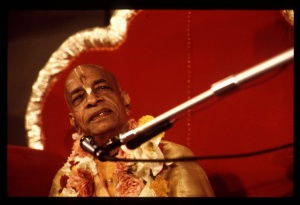CC Madhya 8.111: Difference between revisions
No edit summary |
(Vanibot #0054 edit - transform synonyms into clickable links, which search similar occurrences) |
||
| Line 19: | Line 19: | ||
<div class="synonyms"> | <div class="synonyms"> | ||
''aheḥ'' | ''[//vanipedia.org/wiki/Special:VaniSearch?s=aheḥ&tab=syno_o&ds=1 aheḥ]'' — of the snake; ''[//vanipedia.org/wiki/Special:VaniSearch?s=iva&tab=syno_o&ds=1 iva]'' — like; ''[//vanipedia.org/wiki/Special:VaniSearch?s=gatiḥ&tab=syno_o&ds=1 gatiḥ]'' — the movement; ''[//vanipedia.org/wiki/Special:VaniSearch?s=premṇaḥ&tab=syno_o&ds=1 premṇaḥ]'' — of the loving affairs; ''[//vanipedia.org/wiki/Special:VaniSearch?s=svabhāva&tab=syno_o&ds=1 svabhāva]'' — by nature; ''[//vanipedia.org/wiki/Special:VaniSearch?s=kuṭilā&tab=syno_o&ds=1 kuṭilā]'' — crooked; ''[//vanipedia.org/wiki/Special:VaniSearch?s=bhavet&tab=syno_o&ds=1 bhavet]'' — is; ''[//vanipedia.org/wiki/Special:VaniSearch?s=ataḥ&tab=syno_o&ds=1 ataḥ]'' — therefore; ''[//vanipedia.org/wiki/Special:VaniSearch?s=hetoḥ&tab=syno_o&ds=1 hetoḥ]'' — from some cause; ''[//vanipedia.org/wiki/Special:VaniSearch?s=ahetoḥ&tab=syno_o&ds=1 ahetoḥ]'' — from the absence of a cause; ''[//vanipedia.org/wiki/Special:VaniSearch?s=ca&tab=syno_o&ds=1 ca]'' — and; ''[//vanipedia.org/wiki/Special:VaniSearch?s=yūnoḥ&tab=syno_o&ds=1 yūnoḥ]'' — of the young couple; ''[//vanipedia.org/wiki/Special:VaniSearch?s=mānaḥ&tab=syno_o&ds=1 mānaḥ]'' — anger; ''[//vanipedia.org/wiki/Special:VaniSearch?s=udañcati&tab=syno_o&ds=1 udañcati]'' — appears. | ||
</div> | </div> | ||
Latest revision as of 23:52, 19 February 2024

A.C. Bhaktivedanta Swami Prabhupada
TEXT 111
- aher iva gatiḥ premṇaḥ
- svabhāva-kuṭilā bhavet
- ato hetor ahetoś ca
- yūnor māna udañcati
SYNONYMS
aheḥ — of the snake; iva — like; gatiḥ — the movement; premṇaḥ — of the loving affairs; svabhāva — by nature; kuṭilā — crooked; bhavet — is; ataḥ — therefore; hetoḥ — from some cause; ahetoḥ — from the absence of a cause; ca — and; yūnoḥ — of the young couple; mānaḥ — anger; udañcati — appears.
TRANSLATION
“‘The progress of loving affairs between a young boy and a young girl is like the movement of a snake. On account of this, two types of anger arise between a young boy and girl—anger with cause and anger without cause.’
PURPORT
During the rāsa dance, one form of Kṛṣṇa was between every two gopīs. But by the side of Śrīmatī Rādhārāṇī there was only one Kṛṣṇa. Although this was the case, Śrīmatī Rādhārāṇī still manifested disagreement with Kṛṣṇa. This verse is from the Ujjvala-nīlamaṇi (Śṛṅgāra-bheda-kathana 102), written by Śrīla Rūpa Gosvāmī.